1 事务概念
1、事务:事务是数据库操作最基本单元,逻辑上一组操作,要么都成功,如果有一个失败所有操作都失败。
2、典型场景:银行转账
3、事务四个特性(ACID)
(1)原子性 (要么成功要么失败)
(2)一致性(数据保持一致)
(3)隔离性(互相不干扰)
(4)持久性
2 入门示例
通过银行转账的例子,说明事务的重要性,具体逻辑如下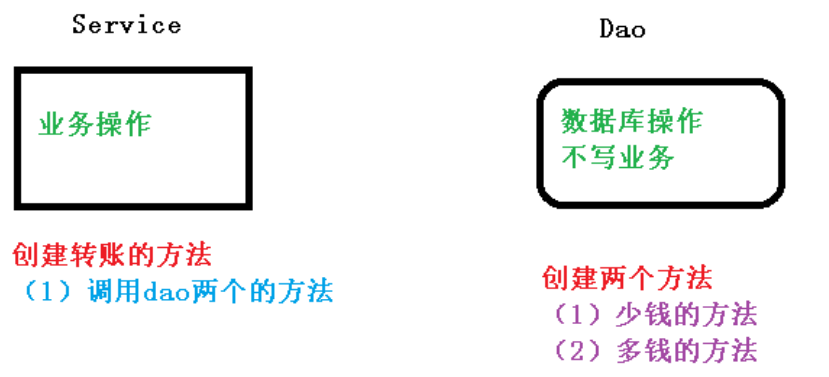
1、在数据库中建表,添加记录
2、创建service,搭建dao,完成对象创建和属性注入
service 注入 dao,在 dao 注入 JdbcTemplate,在 JdbcTemplate 注入 DataSource
3、在dao创建两个方法:多钱和少钱的方法,在service创建转账方法
//service@Servicepublic class UserService {//注入 dao@Autowiredprivate UserDao userDao;//转账的方法public void accountMoney() {//lucy 少 100userDao.reduceMoney();//mary 多 100userDao.addMoney();}}//dao@Repositorypublic class UserDaoImpl implements UserDao {@Autowiredprivate JdbcTemplate jdbcTemplate;//lucy 转账 100 给 mary//少钱@Overridepublic void reduceMoney() {String sql = "update t_account set money=money-? where username=?";jdbcTemplate.update(sql,100,"lucy");}//多钱@Overridepublic void addMoney() {String sql = "update t_account set money=money+? where username=?";jdbcTemplate.update(sql,100,"mary");}}
4、在xml文件中也要弄好组件扫描以及JdbcTemplate对象
<!-- 组件扫描 --><context:component-scan base-package="com.atguigu"></context:component-scan><!-- 数据库连接池 --><bean id="dataSource" class="com.alibaba.druid.pool.DruidDataSource"destroy-method="close"><property name="url" value="jdbc:mysql:///user_db" /><property name="username" value="root" /><property name="password" value="root" /><property name="driverClassName" value="com.mysql.jdbc.Driver" /></bean><!-- JdbcTemplate对象 --><bean id="jdbcTemplate" class="org.springframework.jdbc.core.JdbcTemplate"><!--注入dataSource--><property name="dataSource" ref="dataSource"></property></bean>
但是上面的代码中如果业务逻辑层出现有一方错误,代码实现同步不了,会出现一方成功一方失败的现象
所以要使用到事务的架构(需要使用try catch结构,且前三步在try中执行)
具体步骤为
- 开启事务
- 进行业务操作
- 如果没有发生异常提交事务
- 出现异常的话进行回滚(在catch执行)
3 事务操作
1、事务添加到 JavaEE 三层结构里面 Service 层(业务逻辑层)
2、在 Spring 进行事务管理操作有两种方式:编程式事务管理和声明式事务管理(使用)
3、声明式事务管理
(1)基于注解方式(使用)
(2)基于 xml 配置文件方式
4、在 Spring 进行声明式事务管理,底层使用 AOP 原理
5、Spring 事务管理 API
提供一个接口,代表事务管理器,这个接口针对不同的框架提供不同的实现类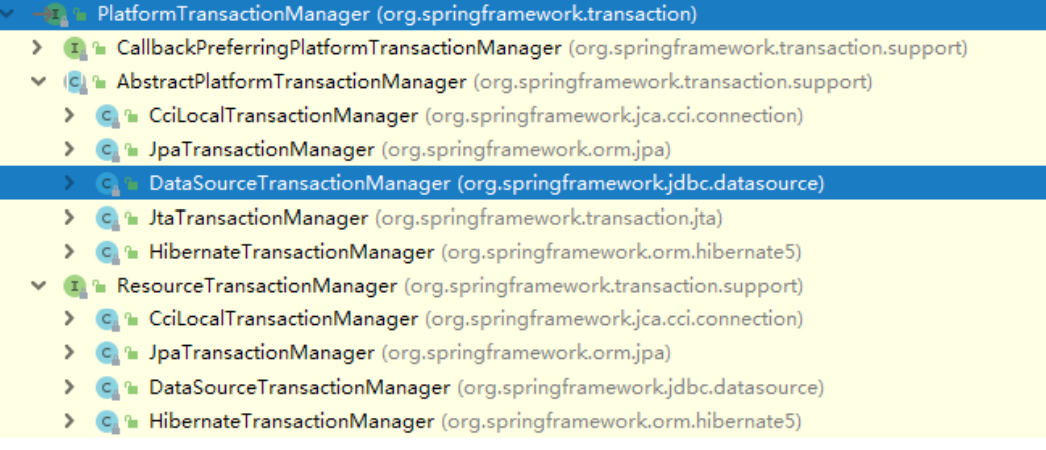
3.1 注解声明式事务管理
1、配置文件配置事务管理器 ```java
2、开启事务注解<br />(1)在配置文件引入名称空间tx```java<beans xmlns="http://www.springframework.org/schema/beans"xmlns:xsi="http://www.w3.org/2001/XMLSchema-instance"xmlns:context="http://www.springframework.org/schema/context"xmlns:aop="http://www.springframework.org/schema/aop"xmlns:tx="http://www.springframework.org/schema/tx"xsi:schemaLocation="http://www.springframework.org/schema/beans http://www.springframework.org/schema/beans/spring-beans.xsdhttp://www.springframework.org/schema/context http://www.springframework.org/schema/context/spring-context.xsdhttp://www.springframework.org/schema/aop http://www.springframework.org/schema/aop/spring-aop.xsdhttp://www.springframework.org/schema/tx http://www.springframework.org/schema/tx/spring-tx.xsd">
(2)开启事务注解
<!--开启事务注解-->
<tx:annotation-driven transaction-manager="transactionManager"></tx:annotation-driven>
3、在 service 类上面(或者 service 类里面方法上面)添加事务注解
(1)@Transactional,这个注解添加到类上面,也可以添加方法上面
(2)如果把这个注解添加类上面,这个类里面所有的方法都添加事务
(3)如果把这个注解添加方法上面,为这个方法添加事务
@Service
@Transactional
public class UserService {
该注解的参数配置
@Transactional共有以下参数
(1)propagation()为传播行为,主要有以下7种
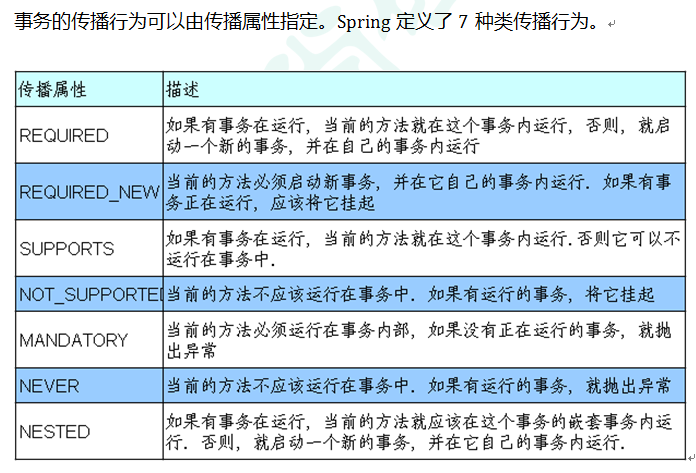
所谓的事务方法:对数据库表数据进行变化的操作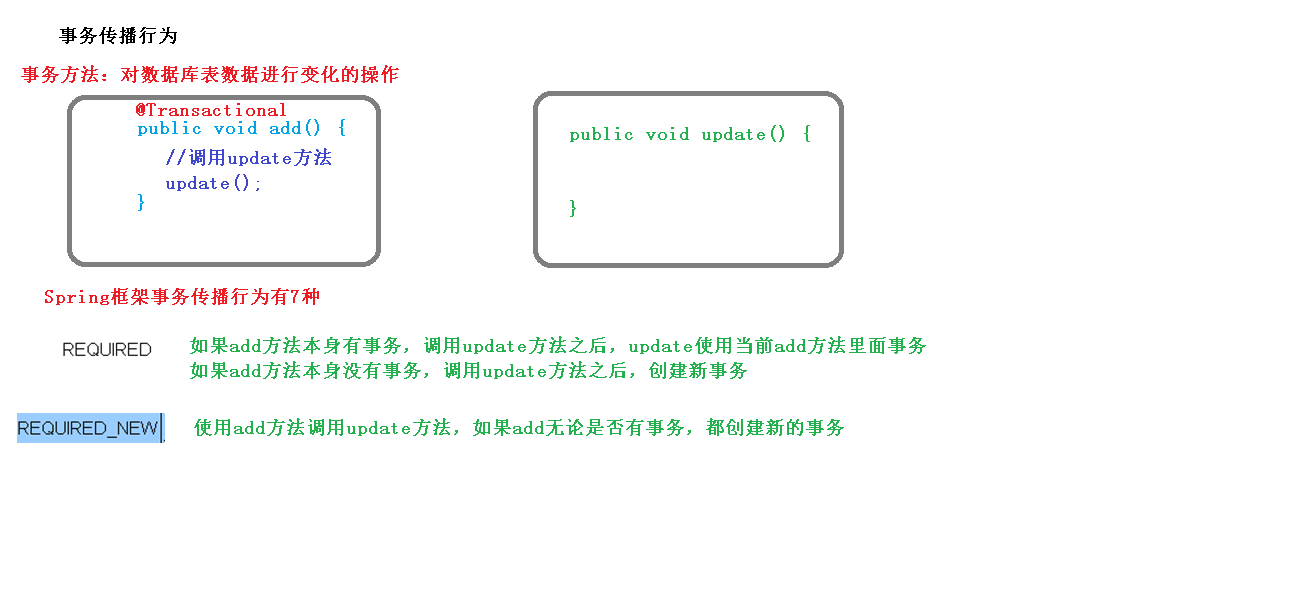
(2)isolation:事务隔离级别
多事务之间操作如果有隔离不会发生什么事情,但没有隔离会发生以下三种情况:脏读、不可重复读、虚(幻)读
- 脏读:一个未提交事务读取到另一个未提交事务的数据(事件回滚,导致A读取B还未提交的事务,应该读取原始数据)
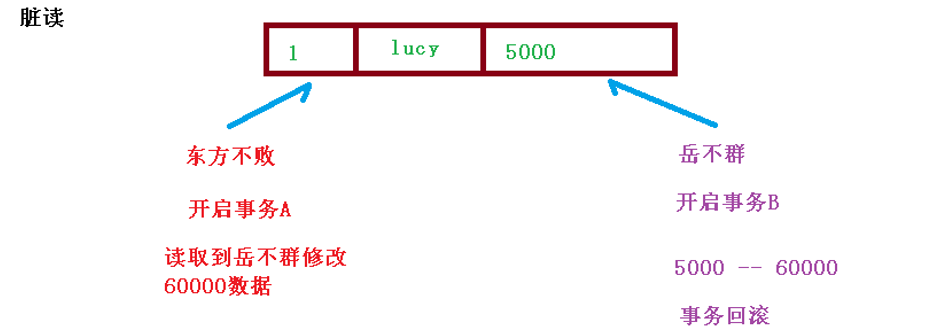
- 不可重复读:一个未提交的事务,获取到了一个已经提交修改的事务(A读取B提交的事务,正常来说都提交了才能读取)
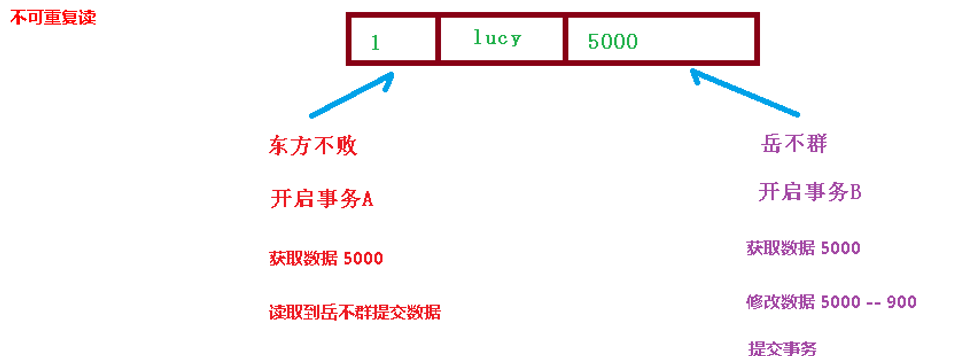
- 幻读:一个未提交的数据获取到了另一个事务添加数据
为了防止以上情况,设置事务的隔离性
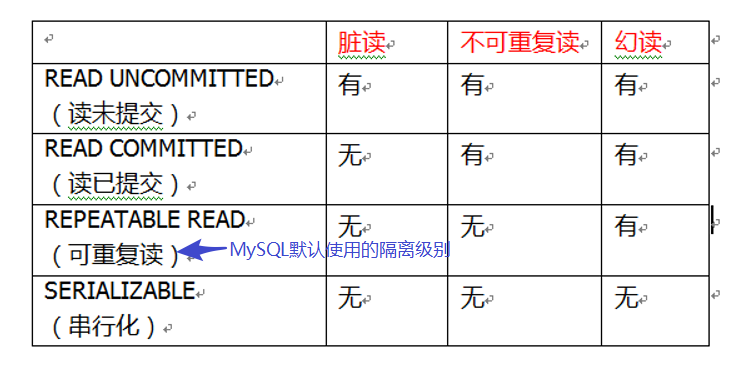
(3)timeout:超时时间
- 事务需要在一定时间内进行提交,如果不提交进行回滚
- 默认值是 -1 ,设置时间以秒单位进行计算
(4)readOnly:是否只读
- 读:查询操作,写:添加修改删除操作
- readOnly 默认值 false,表示可以查询,可以添加修改删除操作
- 设置 readOnly 值是 true,设置成 true 之后,只能查询
(5)rollbackFor:回滚
设置出现哪些异常进行事务回滚
(6)noRollbackFor:不回滚
设置出现哪些异常不进行事务回滚
3.2 xml声明式事务管理
配置文件中进行配置:
- 配置事务管理器
- 配置通知— 增强的部分
配置切入点和切面
<!-- 创建事务管理器--> <bean id="transactionManager" class="org.springframework.jdbc.datasource.DataSourceTransactionManager"> <!-- 注入数据源--> <property name="dataSource" ref="dataSource"></property> </bean> <!--2 配置通知--> <tx:advice id="txadvice"> <!--配置事务参数--> <tx:attributes> <!--指定哪种规则的方法上面添加事务--> <tx:method name="accountMoney" propagation="REQUIRED"/> <!--<tx:method name="account*"/>--> </tx:attributes> </tx:advice> <!--3 配置切入点和切面--> <aop:config> <!--配置切入点--> <aop:pointcut id="pt" expression="execution(* com.atguigu.spring5.service.UserService.*(..))"/> <!--配置切面--> <aop:advisor advice-ref="txadvice" pointcut-ref="pt"/> </aop:config>
3.3 完全注解声明式事务管理
创建配置类,使用配置类代替xml配置文件
@Configuration //配置类
@ComponentScan(basePackages = "com.atguigu") //组件扫描
@EnableTransactionManagement //开启事务
public class TxConfig {
//创建数据库连接池
@Bean
public DruidDataSource getDruidDataSource() {
DruidDataSource dataSource = new DruidDataSource();
dataSource.setDriverClassName("com.mysql.jdbc.Driver");
dataSource.setUrl("jdbc:mysql:///user_db");
dataSource.setUsername("root");
dataSource.setPassword("root");
return dataSource;
}
//创建JdbcTemplate对象
@Bean
public JdbcTemplate getJdbcTemplate(DataSource dataSource) {
//到ioc容器中根据类型找到dataSource
JdbcTemplate jdbcTemplate = new JdbcTemplate();
//注入dataSource
jdbcTemplate.setDataSource(dataSource);
return jdbcTemplate;
}
//创建事务管理器
@Bean
public DataSourceTransactionManager getDataSourceTransactionManager(DataSource dataSource) {
DataSourceTransactionManager transactionManager = new DataSourceTransactionManager();
transactionManager.setDataSource(dataSource);
return transactionManager;
}
}
测试文件如下:
不是扫描xml文件,而是编译class文件的配置类,通过AnnotationConfigApplicationContext这个类
@Test
public void testAccount2() {
ApplicationContext context =
new AnnotationConfigApplicationContext(TxConfig.class);
UserService userService = context.getBean("userService", UserService.class);
userService.accountMoney();
}

